
ISSN:1794-4724 | eISSN:2145-4515



Validation of a Portuguese Version of the Situational Motivation Scale (sims) in Academic Contexts
Validación de la versión portuguesa de la Escala de Motivación Situacional (SIMS) en contextos académicos
Validação da versão portuguesa da Escala de Motivação Situacional (SIMS) em contextos académicos
Vítor Gamboa, Sandra Valadas, Olímpio Paixão
Validation of a Portuguese Version of the Situational Motivation Scale (sims) in Academic Contexts
Avances en Psicología Latinoamericana, vol. 35, no. 3, 2017
Universidad del Rosario
Vítor Gamboa
Universidade do Algarve, Portugal
Sandra Valadas
Universidade do Algarve, Portugal
Received: April 07, 2016
Accepted: November 11, 2016
Additional information
Cómo
citar este artículo: Gamboa, V., Valadas, S., & Paixão, O. (2017).
Validation of a Portuguese Version of the Situational Motivation Scale (SIMS)
in Academic Contexts. Avances en Psicología
Latinoamericana, 35(3),
547-557. doi: https://doi.org/10.12804/revistas.urosario.edu.co/apl/a.4767
Funding
Funding source: Foundation for Science and Technology (FCT), Portugal
Award recipient: Validation of a Portuguese Version of the Situational Motivation Scale (SIMS) in Academic Contexts
Abstract: The Situational Motivation Scale (SIMS), seeks to evaluate the motivation experienced when carrying out a specific task. The purpose of this research was to validate a Portuguese-language version of the scale, using a sample of 409 students, by attempting to reproduce its factor structure. The reliability analysis revealed acceptable internal consistency indexes in all subscales. Construct validity was assessed through Confirmatory Factor Analysis. The contributions of the factors and index of goodness-of-fit demonstrated the need to eliminate two items, which seems to agree with the results in other validation studies. Overall, results revealed that the SIMS is composed of four consistent factors and attested its psychometric quality. The scale does seem to represent a self-report measure of situational intrinsic motivation, identified regulation, external regulation, and amotivation, and can be widely used for the assessment of this construct in Portuguese academic contexts.
Keywords: Self-determination, situational motivation, motivation measures, high school students, undergraduate students.
Resumen: La Escala de Motivación Situacional (SIMS) busca evaluar la motivación experimentada en el desempeño de una tarea específica. El objetivo de esta investigación fue el de validar la versión portuguesa, con una muestra de 409 estudiantes, al intentar reproducir su estructura factorial. Los resultados demuestran una consistencia interna adecuada respecto a las subescalas. La validez del constructo fue evaluado con Análisis Factorial Confirmatorio. Los valores de contribución de cada factor y los índices de ajuste señalan la necesidad de eliminar de dos ítems, que, por su turno, van de encuentro a resultados de otros estudios de validación. En general, los resultados indican que la SIMS está compuesta por cuatro factores consistentes y demuestran su calidad psicométrica. La escala parece ser una buena medida de autorrelato para evaluar la motivación intrínseca, regulación identificada, regulación externa, y desmotivación situacional, pudiendo ser utilizada en la evaluación del constructo en el contexto académico portugués.
Palabras clave: autodeterminación, motivación situacional, medidas de motivación, alumnos de secundaria, alumnos universitarios.
Resumo: A Escala de Motivação Situacional (SIMS) procura avaliar a motivação experimentada no desempenho de uma tarefa específica. O objetivo deste estudo foi validar a versão portuguesa, com uma amostra de 409 estudantes, ao tentar reproduzir a sua estrutura fatorial. Os resultados demostram uma consistência interna adequada relativamente às subescalas. A validade de constructo foi avaliada com a Análise Fatorial Confirmatória. Os valores de contribuição de cada fator e os índices de ajustamento assinalam a necessidade de eliminação de dois itens, que, por seu turno, vai de encontro a resultados de outros estudos de validação. Em geral, os resultados indicam que a SIMS é composta por quatro fatores consistentes e demostram a qualidade psicométrica. A escala parece ser uma boa medida de auto-relato para avaliar a motivação intrínseca, regulação identificada, regulação externa, e amotivação situacional, podendo ser utilizada na avaliação do constructo no contexto acadêmico português.
Palavras-chave: autodeterminação, motivação situacional, medidas de motivação, alunos de ensino secundário, alunos universitários.
Background and purpose
Numerous authors over the past several decades have investigated the concept of motivation. Motivation in academic settings in particular (Jesus, 2000) has been studied as a robust predictor of the quality of academic performance and student learning (Pintrich & Schunk, 2006).
Among the various motivation models, self-determination theory (Deci & Ryan, 1985, 2000, 2008) is perhaps the model that has been used most often as a conceptual framework for much of the existing research in this domain. Globally, SDT holds that the degree of self-regulation depends on the individual’s level of regulation, which in turn varies along a continuum of three types of motivation: intrinsic motivation, extrinsic motivation and amotivation (Deci & Ryan, 1985, 1991).
Intrinsic motivation refers to the motivation experienced by a person who performs an activity due entirely to self-interest and for his or her enjoyment. This is the highest level of self-determination that has emerged as an important phenomenon in the study of educational contexts because it is a natural way of learning that can be systematically promoted by parenting practices and teaching strategies (Deci, Vallerand, Pelletier & Ryan, 1991). For this reason, if we consider its contribution to the explanation of quality and creativity in learning (e.g. Ryan & Deci, 2000), it is of particular importance to know the factors that promote or inhibit intrinsic motivation. Extrinsic motivation, on the other hand, concerns the act of performing a task for an eventual external reward. Inherent to this type of motivation are four levels of regulation: external regulation (less self-determined; performing an activity only to receive a reward or avoid a punishment), introjected regulation (acting to avoid blame or anxiety, intending to ensure self-preservation by protecting the integrity of the ego), identified regulation (the second most self-determined level of regulation, emerging when the importance of a particular behaviour for the achievement of a goal is recognized) and integrated regulation (the most self-determined level of regulation, takes place when the consequences of a behaviour are congruent with the values and needs of the individual and the regulation is fully internalized) (Deci & Ryan, 1985, 1991, 2000, 2008). At the least self-determined end of the continuum lies amotivation. This term refers to the absence of any motivation when facing a particular task and the behaviour is not intrinsically or extrinsically motivated. In cases of amotivation, individuals do not establish any contingency between actions and consequences (Ryan & Deci, 2000).
From this brief description, it follows that the greater the internalization of a task’s value, the more individuals will internalize the regulation processes, translating into greater persistence. Perceptions are also more positive under such conditions, and there is greater engagement with activities (Deci, Eghrari, Patrick & Leone, 1994; Ryan & Deci, 2000).
SDT postulates that the social, relational, and environmental contexts also affect motivational functioning, which is mediated by the three basic and innate psychological needs of autonomy, competence, and relatedness (Deci & Ryan, 1991). Self-determination can be considered directly proportional to the satisfaction of these needs, which are held to be central concepts to understanding the initiation and regulation of behaviour.
According to Vallerand, Pelletier, and Koestner (2008), research based on SDT has revealed that the quality of motivation (e.g. identified regulation, external regulation) is a better predictor than the level of motivation (low or high). More specifically, we note that positive results are derived from more self-determined forms of motivation (intrinsic motivation, integrated regulation, and identified regulation), while less self-determined forms have negative or non-existent relationships with these adaptive results. It is also worth noting that amotivation systematically exhibits a positive relationship with negative or less adaptive results (Vallerand, 1997, 2007; Vallerand & Ratelle, 2002).
Based on SDT, Vallerand (1997) has proposed a hierarchical model of intrinsic and extrinsic motivation (HMIEM). This model supports the existence of three forms of motivation, with different levels of generality, arranged hierarchically according to the degree of specificity (global, contextual, or situational). The global level, which is the highest level of this distribution, defines motivation as a general dispositional tendency to interact with the environment (either intrinsic or extrinsic). In this case, motivation is stable and can be considered a personality trait. The contextual motivation level in this model is a preferential orientation of the individual toward a context or specific area of his/ her life (e.g. sports, work). Lastly, at the situational level, motivation is considered somewhat unstable, given its high sensitivity to environmental factors. At this level, motivation functions as a provision that arises at a particular moment in time and when carrying out a specific task.
The relevance of the distinction between these three levels of generality is that there are mutual influences among them (Vallerand, 1997). Explained in terms of bottom-up and top-down effects, it is possible to understand in greater detail how an individual’s motivation changes over time in the various areas and contexts of his/her life (Guay, Mageau, & Vallerand, 2003, Lavigne, Hauw, Vallerand, & Brunel, Blanchard et al., 2009). In a study recently conducted by Lavigne and Vallerand (2010) in an educational context, for example, situational motivation emerged as a significant predictor of contextual motivation.
It is also important to stress that modifying the quality of motivation in an educational context can be accomplished through small changes at the situational level resulting from a successive number of interactions with the environment and repeated self-internalization (Vallerand et al., 2008).
In this context, we focus on the SIMS, or Situational Motivation Scale (Guay, Vallerand & Blanchard, 2000), which was initially constructed to evaluate situational motivation in an educational context.
Method
Participants
A sample of 409 undergraduate students between 17 and 31 years old (M = 20.79; SD = 2.69) participated in the study. The sample comprised 289 females (70.7 %) and 120 (29.3 %) males. With respect to previous academic performance, 110 students (26.9 %) had already failed at least one year.
Instrument
The Situational Motivation Scale (SIMS) is a 16-item scale with reference to the HMIEM of Vallerand (1997). The items, which assess why the individual is performing a particular activity or task, are equally distributed among the four subscales that represent the dimensions defined by SDT: Intrinsic Motivation (e.g. “Because I think that this activity is interesting”), Identified regulation (e.g. “Because it’s for my own good”), External Regulation (e.g. “Why am I supposed to do it”) and Amotivation (e.g. “I don’t know; I don’t see what this activity brings me.”).
The SIMS asks participants to indicate the extent to which a range of items corresponds to their reasons for performing a specific activity. The subscales assess the dimensions of Intrinsic Motivation (items 1, 5, 9, and 13), Identified Regulation (items 2, 6, 10, and 14), External Regulation (items 3, 7, 11, and 15), and Amotivation (items 4, 8, 12, and 16) in a specific situation. Each one of the items responds to the question: “Why are you performing this task/activity at this time?” Participants indicated the extent to which each item corresponded to their reasons for carrying out a specific activity using a 7-point scale ranging from 1 (does not correspond at all) to 7 (corresponds exactly), with an intermediate score of 4 (corresponds moderately).
Scores from each subscale are averaged across four items, weighed according to their position on the self-determination continuum and used to calculate an SDI of situational motivation using the following formula: SDI = +2* (Intrinsic Motivation) +1* (Identified Regulation) -1* (External Regulation) -2* (Amotivation). Scores on the SIMS also range from -18 to +18 with higher scores indicative of greater self-determination towards the situation being analyzed.
In general, different studies conducted with the SIMS (e.g. Gillet, Vallerand, Lafrenière, & Bureau, 2012; Guay et al., 2000, Martín-Albo, Núñez, & Navarro, 2009; Ratelle, Vallerand, & Baldwin, 2005; Standage & Treasure, 2002) indicated that the scale has satisfactory levels of internal consistency for all subscales, ranging from .70 (Amotivation) (Ratelle et al., 2005) to .95 (Intrinsic Motivation) (Guay et al. 2000). Also, the results of confirmatory factor analysis (CFA) usually support the SIMS structure of four factors (e.g. Guay et al, 2000; Gillet et al., 2012; Martín-Albo et al., 2009; Standage & Treasure, 2002). However, it must be noted that in some of these studies, the rate of adjustment resulted from the elimination of items 10 and 11.
Because the SIMS proved to be a valid instrument for assessing situational motivation in the educational setting, we intended to validate a Portuguese version of this scale by attempting to reproduce the original factor structure using confirmatory factor analysis.
Procedure
The adaptation of the SIMS began with a request for permission to translate and adapt the original scale, which was promptly granted by its authors. A standard translation-back translation (Hill, & Hill, 2008) procedure was used to ensure that the content of each item in the present version was equivalent in meaning to those in the original version of the inventory. Translation to Portuguese was carried out by several Portuguese individuals with good English-language skills. After comparing and integrating the different versions, a revised translated version was submitted for back-translation by a Portuguese individual with very good Portuguese and English language skills. Once minor differences in wording were resolved, no major incompatibilities in the translations were observed. According to Cronbach (1984), these procedures are legitimate, since they contribute to improving the validity and accuracy of the instrument. Creswell (2012) also reports that the use of experts is a method of qualitative analysis that can be used to assess the items on a questionnaire and their form and content in terms of clarity, transparency, and appropriateness for the objectives of the inventory (face validity). This was followed by the adaptation of the instructions (respecting as much as possible the original scale), which guided students on how to respond to the questionnaire using the scale. The Portuguese version of the SIMS maintained the original structure.
SIMS were distributed to the students in two Portuguese public schools during the 2012-2013 academic year. After obtaining the necessary authorization from teachers, the students were informed of the study’s goals and of the conditions for their participation. The tasks set out for the collection of data were contextualized to relate to class lessons. Once the purpose of the research was explained, the scale was distributed to all students, who were instructed to complete it with respect to the preceding academic task. Participation was voluntary and the confidentiality of all information collected was assured. Students were requested to respond as honestly as possible, and there was no time limit. The approximate time needed to complete the instrument was 10 minutes. We also guaranteed the dissemination of the research results. One of the investigators was present at all sessions where the instrument was applied, and later thanked the participants for their collaboration.
Data analysis
In addition to the qualitative analysis described above, we also used quantitative procedures aimed at analyzing the relevance of different parameters to the validity and reliability of the SIMS.
First, we calculated several descriptive statistics and estimated internal consistency reliability using Cronbach’s alpha coefficients for each subscale of the SIMS. The authors of the original SIMS did not include items related to introjected regulation or integrated regulation because they did not think that these dimensions would ultimately be differentiated from the rest. We adopted similar procedures in this study. Second, we calculated correlation coefficients to examine any statistically significant relationships among the factors identified in the original studies. Third, the model was tested by confirmatory factor analysis (CFA) via AMOS to assess model fit to the data (Arbuckle, 2006). To evaluate the fit of the measurement models, comparative fit index (CFI) was used with the root-mean-square error of approximation (RMSEA) in tandem with the standardized root-mean-square residual (SRMR), as recommended by Hu & Bentler (1999) and MacCallum & Austin (2000).
The level of significance in all the statistical tests performed was 0.05. The data were analyzed by means of SPSS (v. 22) and AMOS Graphics (v. 07).
Results
Descriptive Analysis and Internal Consistency of the Subscales
The descriptive statistics of the items used in this study are shown in table 1. The average scores of each item of the scale ranged from 5.95 (item 2) to 1.86 (item 12), with most scores near the midpoint of the 7-point scale. This allowed for some dispersion of the results, as reflected in standard deviation values ranging from 1.28 (item 2) to 2.20 (item 11).
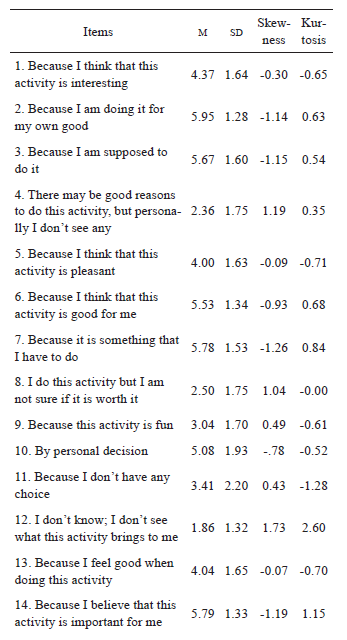

Skewness values suggest that some of the items deviate from the normal distribution (e.g. Maroco, 2003), including items 7 (-1.26), 12 (1.73) and 16 (1.48). With respect to kurtosis, most items had values indicating a mesokurtic distribution, with the exception of item 11 (-1.28), with a flatter distribution (platykurtic), and items 12 (2.60) and 16 (1.65), whose values suggest a leptokurtic distribution.
Regarding the internal consistency of the four subscales of the SIMS (table 2), the results surpass the threshold referenced in the literature (e.g. Hill & Hill, 2008), and showed values varying between .73 (External Regulation) and .89 (Intrinsic Motivation), and are very close to those obtained in the original study (Guay et al., 2000).
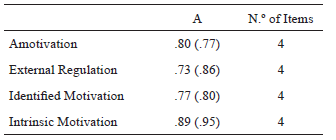
Analysis of the Correlations of the four EMSI Subscales
With respect to correlations between the different domains, the validation study carried out by Guay and colleagues (2000) revealed statistically significant positive correlation values between Intrinsic Motivation and Identified Regulation (r = .36, p <. 001), External regulation and Amotivation (r = .41, p <.01), and negative correlation values between Intrinsic Motivation and Amotivation (r = .41, p <.001).
Overall, we observed highly significant positive correlations between the items of each of the subscales (table 3). The items that showed the highest correlation are related to the following subscales: Amotivation, items 8 and 16 (r = .62, p <.01); External Regulation, items 3 and 7 (r = .71, p <.01); Identified Regulation, items 6 and 14 (r = .63, p <.01) and Intrinsic Motivation, items 1 and 5 (r = .77, p <.01). It is also noted that there are negative correlations between the items integrating Amotivation and Intrinsic Motivation subscales.
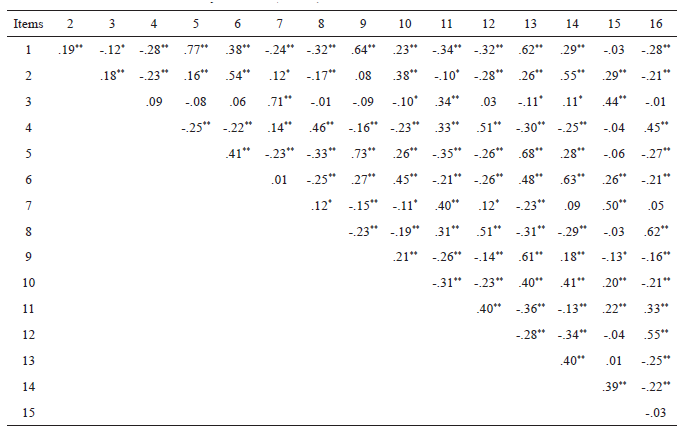
Given the continuum of self-determination, we consider that the observed correlations between the four subscales of the SIMS (table 4) occurred in the theoretically expected direction. That is, we expected a higher correlation between closer or adjacent subscales than among the subscales that are farthest from this continuum. Significant positive correlations were observed between Amotivation and External Regulation (r = .21, p <.01) and between Intrinsic Motivation and Identified Regulation (r = .41, p <.01). On the other hand, significant negative correlation was found between Amotivation and Intrinsic Motivation (r = - .37, p <.01).
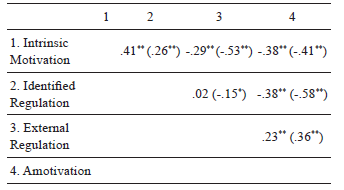
Confirmatory Factor Analysis
To evaluate the fit of the underlying SIMS model with the observed structure, we used confirmatory factor analysis (CFA). The estimation of the model parameters and the assessment of the fit to the matrix were performed using the AMOS Graphics program, which refers to the estimation of the Maximum Likelihood method (Maroco, 2010). The fit of the model was estimated considering the following typology of indices of fit: a) absolute (χ2, RMSEA - root mean square error of approximation), b) incremental (NNFI – non-normed fit index) and c) parsimonious (χ2 / df - weighted Chi-square, CFI - comparative fit index) (e.g. Campana, and Tavares Silva, 2009).
The initial model (Model 1) presents weak adjustment quality indices, since the values deviate from the reference ranges (χ2 = 337,820, p <.001, RMSEA =. 09; NNFI = 87, χ2 / df = 3.86, CFI = .92). For this reason, we conducted a set of procedures that were primarily designed to improve the model fit indices. In a first step, considering the values observed in the squared Mahalanobis, we eliminated participants. These cases were considered the harshest multivariate outliers (p1 and p2 <.001). Subsequently, by analyzing the factor weights of the 16 items, we found that all values are above λ = .50, except for items 10 (IDRG) and 11 (EXTRG). In both cases, the modification indices suggest that a considerable fraction of the item is not explained by the factor on which it saturates. Thus, the item does not contribute to a clear definition of the factorial structure of the SIMS. Because of the foregoing, we reconfigured the model by eliminating items 10 and 11, and conducted a new CFA.
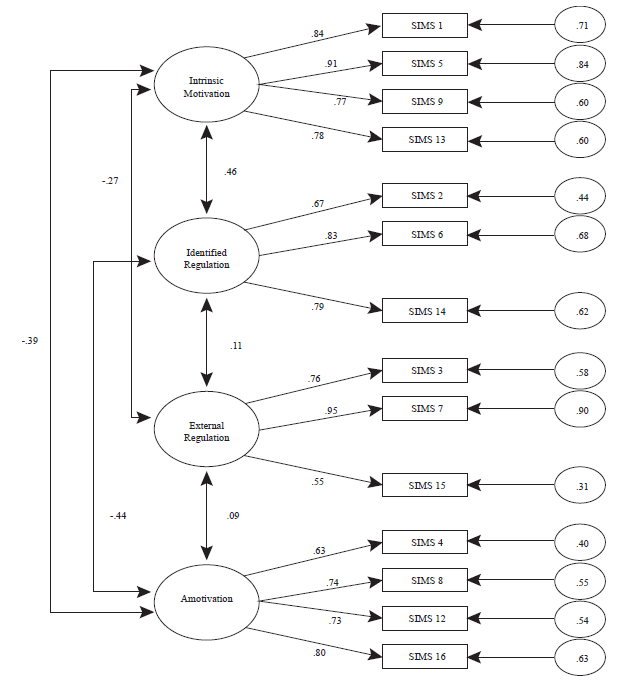
The new CFA for the final model (model 2) has better adjustment scores, although they can still be considered sufferable (χ2 = 260,981, p <.001, RMSEA = .08, NNFI =.91; Χ2/df = 3.68, CFI = .93). In table 5 we analyze the differences regarding goodness-of-fit between Model 1 and Model 2.

Discussion
This study aimed to validate a Portuguese version of the SIMS, assessing its validity and reliability. Overall, the results report good psychometric properties of the Portuguese version of the SIMS in an academic context.
About construct validity, the results of the CFA support the four-factor structure, which reflects the theoretical constructs of amotivation, external regulation, intrinsic motivation, and identified regulation (Deci & Ryan, 1985). This result is consistent with other validation studies (e.g. Guay et al. 2000; Gillet et al., 2012, Martín-Albo et al. 2009; Standage & Treasure, 2002).
As in the studies conducted by Martín-Albo and colleagues (2009), however, as well as Standage and Treasure (2002), the indicators of adjustment of the initial model deviated from the reference values. It was necessary to remove items 10 and 11 from the model because they saturated simultaneously in two factors, reducing the clarity of the factor structure of the SIMS. In addition to an improvement in the index of adjustment, it should be noted that the exclusion of items 10 and 11 increased the internal consistency of the subscales to .80 for identified regulation and .79 for external regulation.
As proposed by SDT (e.g. Deci & Ryan, 1985, 2000, 2008), correlations between the different subscales of the SIMS are organized according to the continuum of self-determination. In this sense, as reported by Guay and colleagues (2000), contiguous subscales exhibit strong and positive correlations, whereas the more distant subscales showed a negative correlation, which also attests to the construct validity of the SIMS. Regarding precision, the different subscales have internal consistencies of above .79, proving the reliability of SIMS. These values are similar to those found in other validation studies (Guay et al. 2000; Martín-Albo et al., 2009).
However, our investigation has some limitations. First, eliminating items can affect the relationships with the various subscales and with the antecedents and consequences. In our opinion, a worthwhile direction for future research would be creating two new items to complete the subscales. Additionally, future research must be performed at other educational levels and by increasing the diversity of activities related to the academic context (e.g. laboratory activities, academic work, presentation of reports, etc.). Other motivational antecedents (e.g. perceived competence, motivational climate) and cognitive and/or affective consequences must also be considered. Testing the psychometric properties of the SIMS in distinct life domains (e.g. work, sports, and health settings) could also improve the robustness of the scale.
Nevertheless, the data obtained provide psychometric support for the use of SIMS to assess different dimensions of situational motivation in an educational context. This finding allows us to advance the study of the relationships between the different levels of generality proposed by HMIEM.
Acknowledgements
This paper was partially financed by the Foundation for Science and Technology (FCT), Portugal.
References
Arbuckle, J. L. (2006). Amos 7.0 User’s Guide. Chicago: SPSS Inc.
Campana, A. N., Tavares, M. C., & Silva, D. (2009). Modelagem de Equações Estruturais: Apresentação de uma abordagem estatística multivariada para pesquisas em Educação Física. Motricidade, 5, 59-80.
Creswell, J. W. (2012). Educational Research: Planning, conducting and evaluating quantitative and qualitative research (4th ed.). New Jersey: Pearson Education.
Cronbach, L. J. (1984). Essentials of Psychological Testing (4th ed.). New York: Harper Row.
Deci, E. L., & Ryan, R. M. (1985). Intrinsic motivation and self-determination in human behavior. New York: Plenum.
Deci, E. L., & Ryan, R. M. (1991). A motivational approach to self: Integration in personality. In R. Dienstbier (Ed.) Nebraska Symposium on motivation, 38 (pp. 237-288). Lincoln: University of Nebraska Press.
Deci, E. L., & Ryan, R. M. (2000). The “what” and “why” of goal pursuits: Human needs and the self-determination of behavior. Psychological Inquiry, 11, 222-268.
Deci, E. L., & Ryan, R. M. (2008). Facilitating optimal motivation and psychological well-being across life’s domains. Canadian Psychology, 49, 14-23.
Deci, E. L., Eghrari, H., Patrick, B. C., & Leone, D. R. (1994). Facilitating internalization: The self-determination theory perspective. Journal of Personality, 62, 119-142.
Deci, E. L., Vallerand, R. J., Pelletier, L. G., & Ryan, M. R. (1991). Motivation and education: The self-determination perspective. Educational Psychologist, 26, 325-346.
Gillet, N., Vallerand, R. J., Lafrenière, M. K., & Bureau, J. S. (2012). The mediating role of positive and negative affect in the situational motivation-performance relationship. Motivation and Emotion, 1-15.
Guay, F., Mageau, G. A., & Vallerand, R. J. (2003). On the hierarchical structure of self-determined motivation: A test of top-down, bottom-up, reciprocal and horizontal effects. Personality and Social Psychology Bulletin, 29, 992-1004.
Guay, F., Vallerand, R. J., & Blanchard, C. (2000). On the assessment of situational intrinsic and extrinsic motivation: The situational motivation scale (SIMS). Motivation and Emotion, 24, 175-213.
Hill, M. M., & Hill, A. (2008). Investigação por Questionário (2ª Edição). Lisboa: Edições Sílabo.
Hu, L.-T., & Bentler, P.M. (1999) Cutoff criteria for fit indexes in covariance structure analysis: Conventional criteria versus new alternatives. Structural Equation Modeling: A Multidisciplinary Journal, 6(1), 1-55.
Jesus, S. N. (2000). Motivação e Formação de Professores. Coimbra: Quarteto.
Lavigne, G. L., & Vallerand, R. J. (2010). The Dynamic Processes of Influence Between Contextual and Situational Motivation: A Test of the Hierarchical Model in a Science Education Setting. Journal of Applied Social Psychology, 40, 2343-2359.
Lavigne, G. L., Hauw, N., Vallerand, R. J., Brunel, P., Blanchard, C., Cadorette, I., & Angot, C. (2009), On the dynamic relationships between contextual (or general) and situational (or state) motivation toward exercise and physical activity: A longitudinal test of the top-down and bottom-up hypotheses. International Journal of Sport and Exercise Psychology, 7, 147-168.
MacCallum, R., & Austin, J. T. (2000). Applications of Structural Equation Modeling in Psychological Research. Annual Review Psychology, 51, 201-226.
Maroco, J. (2003). Análise Estatística com Utilização do SPSS (2ª Edição). Lisboa: Edições Sílabo, Lda.
Maroco, J. (2010). Análise de Equações Estruturais: Fundamentos Teóricos, Software e Aplicações. Pêro Pinheiro: ReportNumber, Lda.
Martín-Albo, J., Núñez, J. L., & Navarro, J. G. (2009). Validation of the Spanish version of the situational motivation scale (EMSI) in the educational context. The Spanish Journal of Psychology, 12, 799-807.
Pintrich, P. R., & Schunk, D. H. (2006). Motivación en Contextos Educativos: Teoría, Investigación y Aplicaciones (2ª Ed.). Madrid: Pearson Educación.
Ratelle, C. F., Baldwin, M. W., & Vallerand, R. J. (2005). On the cued activation of situational motivation. Journal of Experimental Social Psychology, 41, 482-487.
Ryan, M. R., & Deci, R. L. (2000). Intrinsic and extrinsic motivations: Classic definitions and new directions. Contemporary Educational Psychology, 25, 54-67.
Standage, M., & Treasure, D. C. (2002). Relationship among achievement goal orientations and multidimensional situational motivation in physical education. British Journal of Educational Psychology, 72, 87-103.
Vallerand, R. J. (1997). Toward a hierarchical model of intrinsic and extrinsic motivation. Advances in Experimental Social Psychology, 29, 271-360.
Vallerand, R. J. (2007). Intrinsic and extrinsic motivation in sport and physical activity: A review and a look at the future. In G. Tenenbaum & R. Eklunds (Eds.), Handbook of sport psychology 3rd ed. (pp. 59-83). New York: John Wiley & Sons.
Vallerand, R. J., & Ratelle, C. F. (2002). Intrinsic and extrinsic motivation: A hierarchical model. Handbook of self-determination research (pp. 37-63). Rochester, NY: University of Rochester Press.
Vallerand, R. J., Pelletier, L. G., & Koestner, R. (2008). Reflections on self-determination theory. Canadian Psychology, 257-261.
Author notes
a38861@ualg.pt



